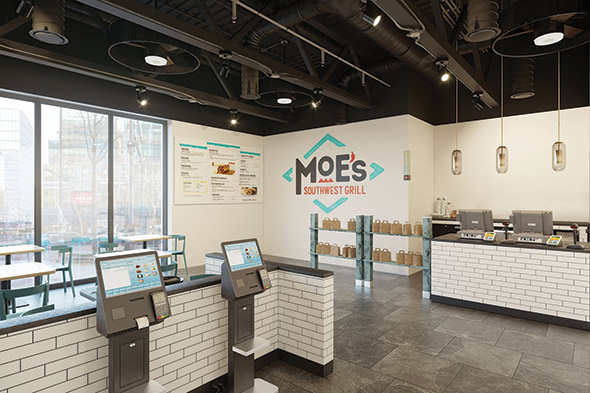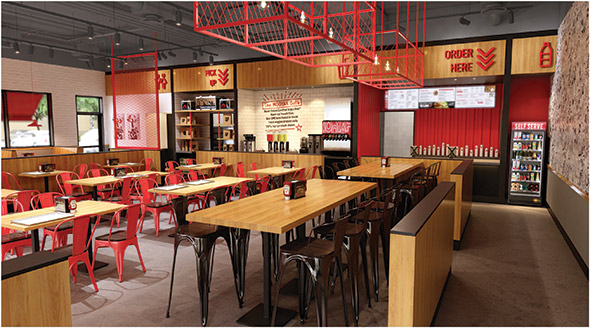Consumers continue to show a growing appetite for online and mobile ordering options in the restaurant industry and beyond. In fact, food purchased for off-premises consumption now accounts for 60 percent of all restaurant occasions, according to data from the National Restaurant Association.
Third-party delivery companies remain a driving force in this phenomenon. During an earnings call last summer, Uber’s CEO noted the food category may be larger than the ride category; Uber’s food delivery model, Uber Eats, has accelerated in the last year as the service expands globally. Grubhub and DoorDash also showed positive growth in 2019 financial reports.

In response to consumers’ seemingly insatiable appetite to enjoy restaurant-quality food off premises, operators from all segments now strive to accommodate both third-party delivery drivers and consumers ordering directly from a restaurant’s own app or online platform. Despite this growth, many restaurants are still catching up to the digital ordering craze. In fact, only 37 percent offer digital ordering, according to data from the National Restaurant Association.
Regardless of whether orders come directly through a restaurant’s own online platform or through a third-party delivery model, restaurateurs need to find ways to satisfy this growing demand for pickup and delivery options.
For many fast-casual chains, the solution has been a simple approach: give pickup stations their own discrete space and make it simple for customers to access meals they’ve already paid for. Three well-known chains have each taken similar yet slightly different approaches to this ever-more-important aspect of the business to position themselves for the future.
Two New Trials
As technology advances, chains continue to push the envelope on digitization. Last year, Washington, D.C.-based Sweetgreen, a salad-based fast-casual chain, began experimenting with bringing pickup stations right to its customers when it created “sg Outpost.” These unique pickup stations aren’t located in the stores; instead, they sit in the lobbies of companies that contract with Sweetgreen restaurants.
Customers who work for those companies can order their Sweetgreen meals online, and the restaurant will deliver them to the appropriate sg Outpost. According to the company’s website, Sweetgreen has agreements with five businesses. But the company has ambitious plans to expand the concept further into businesses, as well as schools and hospitals.
But the ultimate in digitization to date comes from Moe’s Southwest Grill. Thefast-casual chain plans to open its first all-digital/kiosk-based restaurant. Restaurants in Pittsburgh and Charlottesville, Va., will open early in 2020.
Firehouse Subs’ Pickup Approach
 Firehouse Subs opened a prototype store last summer that distinctly defines a spot for to-go orders and third-party delivery pickups.One of the early adopters of pickup stations was Jacksonville, Fla.-based Firehouse Subs. John Namey, vice president of real estate services, says the feature satisfies a growing desire among customers for convenience. The chain includes pickup stations anywhere third-party delivery is available.
Firehouse Subs opened a prototype store last summer that distinctly defines a spot for to-go orders and third-party delivery pickups.One of the early adopters of pickup stations was Jacksonville, Fla.-based Firehouse Subs. John Namey, vice president of real estate services, says the feature satisfies a growing desire among customers for convenience. The chain includes pickup stations anywhere third-party delivery is available.
“It was fortuitous, the way our restaurants were designed, because the food flows from the cash register toward the front door,” Namey explains. “There is a cutout where staff come out to deliver food to the dining area. So, we already had a convenient space.”
All of Firehouse’s legacy restaurants now include a pickup area, which Namey describes as “pretty much like a chip rack.” There is a section of the rack set aside for each of the third-party delivery systems operating in the restaurant’s geographical area; the amount of space given is determined by how much each service is used.
Stores also designate a section for Firehouse’s Rapid Rescue To Go program. Customers who placed their orders digitally, either by computer or mobile app, pick up their food in this space. Names are printed on the customers’ receipts.
The rack does not include equipment to hold food at temperature, though. Firehouse’s goal is to prepare food as close to customers’ pickup times as possible, so that neither customer nor food sits very long waiting for the other, Namey says.
The system has worked well, Namey says, but he admits the setup is a bit inconvenient for staff, who must come around from behind the counter in order to place packages on the rack. This problem has been rectified in Firehouse’s new restaurant design, which is in a test phase now in Jacksonville.
“Food flows a bit differently in the new stores,” Namey says. “A cubby system has been built near the finishing station. Now, instead of staff walking around to the front of the line to fill a rack, they can just reach through the cubby and set the food on a shelf.”
Firehouse Subs opened its “next generation” store last summer in Durbin Park, a mixed-use development in Jacksonville, Fla. Noticeably, the design and flow of the space gears toward off-premises orders. “We’ve seen a huge shift toward more off-premises,” says Jay Miller, director of product development.
Off-premises now makes up 62 percent of Firehouse’s business according to the company. That’s one of the reasons the 1,600-square-foot prototype includes seating for just 28 compared to the previous 50-person seating area. “We don’t need as much dining room space as in the past. Everything is now more front-focused.”
In Firehouse Subs’ traditional model, customers went “deep into the restaurant to order,” Miller explains. Now, the cashier station sits near the front, leaving customers no question about where to go when they walk through the door. Most of the dining area seating is now at the rear of the store, away from all the business of the queueing line.
The need for a larger waiting area for off-premises customers became evident once the prototype opened, Miller says, something the chain is tweaking before releasing the new model to franchisees.
In the back of the house, the kitchen shrank by 25 percent in the prototype, with the primary goal to save steps for employees. “We redesigned the kitchen to be more stationary, so employees could be more productive from one spot,” Miller says. “We eliminated the crossover from the back of the line to the front of the line and got steamers that are more efficient.”
Instead of six to eight steamer units per location, the prototype now includes just one or two. The new custom-designed sandwich steamers are also stackable to save space. They replace clamshell units and reduce the area to an 8-foot section for the steamers. That was previously a 10- to 12-foot section, Miller says. “We picked up efficiency with the steamers and have faster toasting equipment for the bread. Overall, we were able to cut a minute total out of prep time for subs.”
Chipotle Takes Drive-Thru Digital
“We know that now, more than ever, guests give preference to speed and convenient options,” says Tabassum Zalotrawala, chief development officer for Newport Beach, Calif.-based chain Chipotle. “Customers are always seeking additional points of access and ways to make their experience even more convenient.”
 Chipotle’s drive-up pickup offering, dubbed “Chipotlanes,” allows customers who use the chain’s app or online ordering system to pick orders up via what looks like a traditional drive-thru lane. A rack system (pictured below) holds to-go orders inside the store.
Chipotle’s drive-up pickup offering, dubbed “Chipotlanes,” allows customers who use the chain’s app or online ordering system to pick orders up via what looks like a traditional drive-thru lane. A rack system (pictured below) holds to-go orders inside the store.
 In response to those desires, Chipotle rolled out two changes to make it easier for remote-order customers to grab their food and go. First is the addition of what Chipotle calls “digital make lines.” These make lines are located in the back of the house and handle digital orders only, so there is no crossover between orders from walk-in customers.
In response to those desires, Chipotle rolled out two changes to make it easier for remote-order customers to grab their food and go. First is the addition of what Chipotle calls “digital make lines.” These make lines are located in the back of the house and handle digital orders only, so there is no crossover between orders from walk-in customers.
Staff package and place orders at the pickup station when ready for either customer pickup or the third-party delivery driver. This area consists simply of racks with four wooden shelves, identified by a sign at the top. Shelves are alphabetized to make it easier for customers and drivers to find the appropriate order.
“Our digital make lines and pickup shelves reduce friction throughout the entire process from order to pickup,” says Zalotrawala. “This served as a jumping-off point and inspiration for Chipotlanes.”
Chipotlanes enable customers who order online or via the app to pick up their orders without leaving their cars — it’s basically a drive-thru setup without the traditional drive-thru ordering option. Instead, the lanes are strictly for the pickup of orders already placed and paid for, and Chipotle has been testing new types of signage and lighting to make that fact clearer.
As of October 2019, the chain had 20 Chipotlanes installed. Company executives told investors they plan to add the lanes to 60 more stores by the end of 2019 and include them at least at half of the 150 or so units the company expects to open in 2020.
Starbucks and Dunkin’ Donuts are also experimenting with digital drive-thru concepts.
MOOYAH Burgers, Fries & Shakes
When Dallas-based MOOYAH decided to do a brand refresh early in 2018, one of the areas on which the company focused was how it handled online orders and customer requests for third-party delivery.
 This rendering shows MOOYAH Burger, Fries & Shakes’ new design, which will launch in early 2020.
This rendering shows MOOYAH Burger, Fries & Shakes’ new design, which will launch in early 2020.
“We agreed that our design was not going to position us well for the future,” says Natalie Anderson Liu, MOOYAH’s vice president of brand, “and didn’t meet the growing consumer need for third-party delivery. We needed to have a purposeful place for to-go and third-party orders.”
Prior to the redesign, which will officially launch in two stores early in 2020, MOOYAH’s pickup stations were different, in terms of location and design, from store to store. Anderson Liu says this ad hoc situation was not going to be sustainable, so the new store design features strategically placed shelving for to-go and delivery orders.
“The pickup stations are located near the back of the house, to make it easy for kitchen team members to reach to place the packaged orders,” says Liu. “They are also near a side door to the restaurant, to allow customers to bypass the traffic already on the line. They’ve already paid for their meal, so there is no need for them stand in a line or interact with staff.”
The pickup stations feature simple racks made of red powder-coated metal to fit the overall color scheme of the restaurant. The chain believes it can double revenue from third-party delivery alone, says Liu, with the new design. Third-party delivery currently represents 4 percent of MOOYAH’s total sales.
Combined with the new pickup station, back-of-the-house computer screens improve accuracy and speed of production. Not only does it enhance flow-through, it also helps staff keep better track of digital orders, which they must prepare to match the time at which customers are expected to arrive to pick up their orders.



